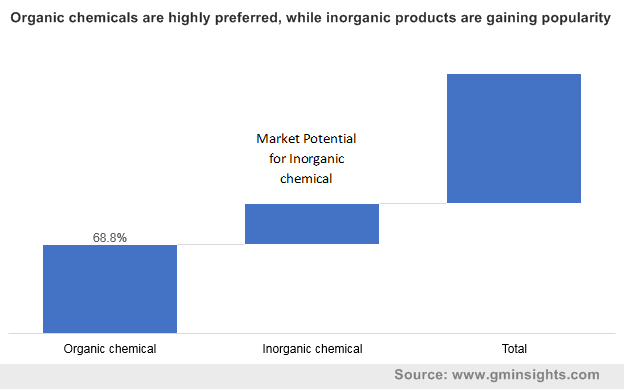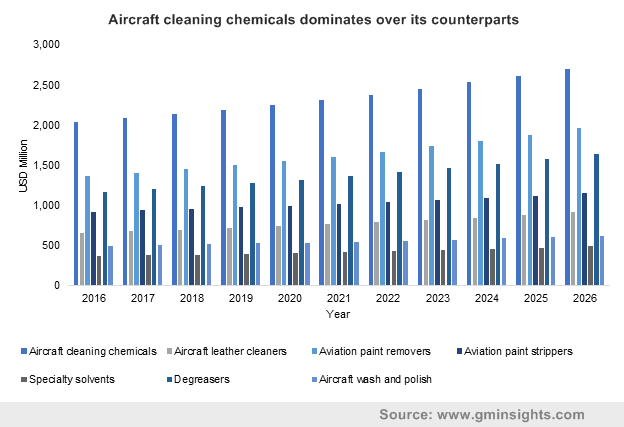Home > Construction > Construction Materials > Structural Materials > Aerospace Maintenance Chemicals Market
Aerospace Maintenance Chemicals Market Analysis
- Report ID: GMI2105
- Published Date: Nov 2019
- Report Format: PDF
Aerospace Maintenance Chemicals Market Analysis
According to SGI Aviation and IATA, over 27,000 commercial aircrafts were operating across the globe till 2015 with an average age of 12.6 years. Additionally, around 50% of aircrafts are still in operating conditions with an age of around 25 years. These figures are showcasing huge requirement for maintenance activities, thereby boosting the maintenance chemicals revenue generation over the study timeframe. Moreover, according to the Maintenance Cost Task Force (MCTF) of IATA, representing around 18% of the world’s aircraft fleet in 2017, reported that its airline fleet size has an average age of 8.9 years.
In January 2019, Boeing announced that the company sold 806 commercial jets in 2018, up by 6% as compared to 2017. Also, Airbus SE delivered 800 commercial aircrafts up by 11% as compared to 2017. Heavy maintenance activities are performed around every 18 months to 6 years depending on the aircraft types. Thus, aircrafts sold in 2018 will be in maintenance cycle from 2020 and onwards, thereby showcasing higher maintenance chemicals demand over the projected timeframe.
Limited chemical shelf life along with the requirement of proper storage facilities with adequate temperature and humidity are escalating the inventory cost. Hazardous nature of several chemicals is adversely affecting the health of aircraft maintenance employees, thereby imposing constant pressure on industry players to develop new products with reduced hazardous materials. Additionally, stringent government regulations such as REACH legislation are demanding industry participants to develop substitutes for various cleaners & solutions.
Passenger’s experience is playing a significant role in selecting airlines, thereby airlines are providing attention towards offering cleaner and hygiene experience to passengers. Rising frequencies of flights and continuous contact of cabin interior with passengers degrades the aircraft interiors, thereby requiring frequent cleaning operations. Aircraft cleaning accounts for around half of the volume share in aerospace maintenance chemicals market.
Aviation paint strippers will showcase considerable growth in the aerospace maintenance chemicals market owing to rising painting activities to provide and maintain unique aesthetics of aircrafts by various airlines. These are mainly hydrogen peroxide activated chemicals designed to remove polyurethane, epoxy, and other paints from the aircraft exteriors and interiors. The availability of several paint strippers with easy to operate and non-toxicity of chemicals are further supporting the product demand.
Growing commercial aircraft fleet across the globe owing to increasing international and domestic flights are showcasing considerable growth in the aerospace maintenance chemical market. For instance, in June 2019, India’s domestic air passenger traffic rose by 7.9% as compared to June 2018. Additionally, according to IATA, the overall global air passenger traffic grew by 5% in June 2019. Commercial aircrafts in aerospace maintenance chemicals market holds over 45% of the revenue share in 2018.
Business aircrafts will showcase considerable growth in the market owing to rising international business travels. Business aircrafts are required to maintain high luxury interiors to enhance customer satisfaction. The aircrafts use several luxurious leather interiors, thereby requiring frequent leather cleaner to ensure higher life of aircraft soft goods. Introduction of new high-end business aircrafts has resulted in the increased sales of aircrafts in 2018. According to the General Aviation Manufacturers Association (GAMA), 707 business jets were delivered in 2018 as compared to 677 units in 2017.

Stringent government regulations along with rising concern for health safety are the main factors driving the development in organic chemicals. Organic chemicals are preferred owing to the availability of several product portfolio with faster maintenance operations. Usage of lower volatile organic compound content products are minimizing the adverse health effects. Additionally, growing demand for toxic free chemicals coupled with suitable viscosity of these chemicals will further escalate the aerospace maintenance chemicals market demand.
Rising presence of low-cost carriers in Europe is likely to showcase significant growth potential over the projected timeframe. According to the CAPA – Centre for Aviation, passengers travelling with Europe’s 30 airliners groups using LLC increased from 40.6% to 42.3% in 2018 as compared to 2017. Affordable and lower fares offered by these carriers for international flights such are augmenting their demand. Additionally, improved chemical performance and stringent regulations are providing opportunity for players to enhance product offering and achieve competitiveness in industry.

